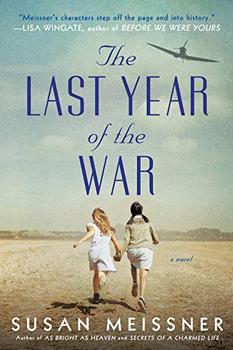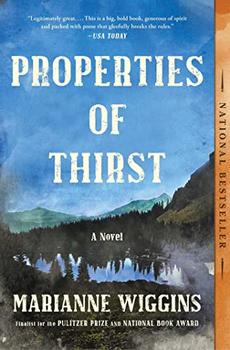Summary | Excerpt | Reading Guide | Reviews | Beyond the book | Read-Alikes | Genres & Themes | Author Bio

36 out of 37 First Impressions reviewers gave Susan Meissner's The Last Year of the War four or five stars, for an overall rating of 4.6.
What it's about:
The Last Year of the War follows the life of Elise Sontag and her family. When Elise's father is arrested by the FBI as an enemy alien during World War II, their peaceful life in Davenport, Iowa is disrupted. Poverty and uncertainty follow the family as they are separated from each other, reunited in an internment camp in Texas, and finally repatriated to Germany, where Allied pilots were still dropping bombs. The story is also about the friendship that arises between Elise and Mariko, a Japanese internee at the same camp in Texas. Sixty years later, at the age of 77, Elise has been diagnosed with Alzheimer's. She becomes determined to reconnect with Mariko, who she has not seen or heard from since the camp (Jean L). This moving narrative tells of Elise's search for home, happiness and a sense of identity that keeps her true to herself. This is the story of a woman who stayed the course throughout countless obstacles (Marcia C).
Most thought the book was superb historical fiction:
This was a truly outstanding book about a little-known series of events during WWII. I had no idea that American citizens of German heritage were interned at the same time as those of Japanese heritage. Nor did I know that some of these American citizens were "traded" for American citizens caught behind enemy lines. This excellent historical fiction explains how and why that came to pass, and what happened to two families who were repatriated to their parents' country of origin (Janet H). Meissner has brilliantly taken this dark period in America's history and made it accessible to the mainstream reader (Judi R).
The book touches on many important subjects:
The author explores issues of injustice, the hardships of war and feelings about "place" with an engaging story and well-developed characters (Rosemary C). There are broad themes of friendship, love, identity, family loyalty and the damages of war played out against an important historical backdrop (DeAnn A).
Many readers also compared Elise's situation to that of today's immigrants:
The parallels to present day immigration issues are unmistakable, and caused me to reflect upon the current plight of the DREAMers (Maribeth R). This book sheds light on a part of the immigration debate that most Americans never consider – what happens to ordinary people caught in untenable situations (Becky H).
First Impressions reviewers were also impressed with the author's characters:
Meissner's characters embody a sincerity and clarity that makes them come alive to the reader and remain memorable long after the book is read (Marianne L). They seemed so real! I really cared about both young girls, one from a German family and one from a Japanese family, and the friendship they forged in the internment camp (Jean N). Perhaps they should be re-named CAREacters because when you encounter them, you take them into your heart (Maribeth R).
Some felt the last third of the book was a let-down:
The story is a compelling and interesting piece of historical fiction, with a believable account of how an American-born teenager might have reacted. The book is less successful when it verges on soap opera after the war with the drama of Elise's marriages and interactions with her in-laws. The picture of Elise in old age feels contrived and does not add to an otherwise good book (Joy E). For the last 100 pages or so I felt too many serendipitous events took place for it to be a satisfying read (Henry W).
The general consensus, however, was that it was a wonderful, well-paced novel:
Warning: when you begin this volume, ensure your next day or two are unencumbered. It is guaranteed you will not want to stop reading once you begin Meissner's tale of tragedy, hope and reconciliation (Maribeth R). I was completely absorbed by this historically accurate novel about a young German American girl's experience during World War II and after (Rosemary C). Well-written and well-researched, this book is one that should not be missed (Becky H). It was very easy to read, very engaging and definitely hard to put down (Mary D).
Recommended for:
Fans of historical fiction are sure to love this exceptional novel and will add it to their favorites of the year (Judi R). There is much food for discussion here. It would be a great book club pick, especially in light of the internment camps once again being set up in Texas (Marcia C).
![]() This review was originally published in The BookBrowse Review in March 2019, and has been updated for the
April 2020 edition.
Click here to go to this issue.
This review was originally published in The BookBrowse Review in March 2019, and has been updated for the
April 2020 edition.
Click here to go to this issue.

If you liked The Last Year of the War, try these:

by Marianne Wiggins
Published 2023
Fifteen years after the publication of Evidence of Things Unseen, National Book Award and Pulitzer Prize finalist Marianne Wiggins returns with a novel destined to be an American classic: a sweeping masterwork set during World War II about the meaning of family and the limitations of the American Dream.

by Leah Weiss
Published 2021
A Southern story of friendship forged by books and bees, when the timeless troubles of growing up meet the murky shadows of World War II.
What really knocks me out is a book that, when you're all done reading, you wish the author that wrote it was a ...
Click Here to find out who said this, as well as discovering other famous literary quotes!
Your guide toexceptional books
BookBrowse seeks out and recommends the best in contemporary fiction and nonfiction—books that not only engage and entertain but also deepen our understanding of ourselves and the world around us.